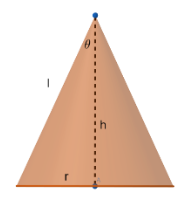
Show that semi-vertical angle of right circular cone of given surface area and maximum volume a given slant height $l$ is ${{\tan }^{-1}}\left( \dfrac{1}{2\sqrt{2}} \right)$.
Answer
509.4k+ views
Hint: First find the surface area of the cone. After that, take $l=\sqrt{{{h}^{2}}+{{r}^{2}}}$ and compare to get the volume. Then for maximum volume, $\dfrac{dV}{dr}=0$, from this you will get the value of $S$ and substitute in $l$, you will get the value of $l$ in terms of $r$ and also you will get the value of $h$. The take $\tan $ of semi vertical angle and you will get the answer.
Complete step-by-step answer:

Now the surface area of the cone will be $S=\pi {{r}^{2}}+\pi rl$ where r is the radius and l is the slant height of the cone.
Now $l=\dfrac{S-\pi {{r}^{2}}}{\pi r}$……….. (1)
Also from above figure we know that ${{h}^{2}}+{{r}^{2}}={{l}^{2}}$, where $h$ is the vertical height of the cone.
So we get, $l=\sqrt{{{h}^{2}}+{{r}^{2}}}$ ……….(2)
From (1) and (2), we get,
$\sqrt{{{h}^{2}}+{{r}^{2}}}=\dfrac{S-\pi {{r}^{2}}}{\pi r}$
Squaring both sides we get,
\[\begin{align}
& {{h}^{2}}+{{r}^{2}}={{\left( \dfrac{S-\pi {{r}^{2}}}{\pi r} \right)}^{2}} \\
& {{h}^{2}}=\left( \dfrac{{{S}^{2}}+{{\pi }^{2}}{{r}^{4}}-2\pi S{{r}^{2}}}{{{\pi }^{2}}{{r}^{2}}} \right)-{{r}^{2}} \\
& {{h}^{2}}=\left( \dfrac{{{S}^{2}}+{{\pi }^{2}}{{r}^{4}}-2\pi S{{r}^{2}}-{{\pi }^{2}}{{r}^{4}}}{{{\pi }^{2}}{{r}^{2}}} \right) \\
& {{h}^{2}}=\left( \dfrac{{{S}^{2}}-2\pi S{{r}^{2}}}{{{\pi }^{2}}{{r}^{2}}} \right) \\
& h=\dfrac{\sqrt{{{S}^{2}}-2\pi S{{r}^{2}}}}{\pi r} \\
\end{align}\]
Now volume of cone V$=\dfrac{1}{3}\pi {{r}^{2}}h=\dfrac{1}{3}\pi {{r}^{2}}\dfrac{\sqrt{{{S}^{2}}-2\pi S{{r}^{2}}}}{\pi r}$
V$=\dfrac{r}{3}\sqrt{{{S}^{2}}-2\pi S{{r}^{2}}}$
For maximum volume, $\dfrac{dV}{dr}=0$.
$\begin{align}
& \dfrac{1}{3}\sqrt{{{S}^{2}}-2\pi S{{r}^{2}}}+\dfrac{r}{3}\dfrac{-4\pi Sr}{2\sqrt{{{S}^{2}}-2\pi S{{r}^{2}}}}=0 \\
& \dfrac{1}{3}\sqrt{{{S}^{2}}-2\pi S{{r}^{2}}}=\dfrac{r}{3}\dfrac{2\pi Sr}{\sqrt{{{S}^{2}}-2\pi S{{r}^{2}}}} \\
& {{S}^{2}}=4\pi S{{r}^{2}} \\
\end{align}$
we know that, $S\ne 0$.
So $S=4\pi {{r}^{2}}$
Now taking (1) and substituting the $S=4\pi {{r}^{2}}$ we get,
$l=\dfrac{4\pi {{r}^{2}}-\pi {{r}^{2}}}{\pi r}=3r$
So $l=\sqrt{{{h}^{2}}+{{r}^{2}}}$
$\begin{align}
& 9{{r}^{2}}={{h}^{2}}+{{r}^{2}} \\
& h=2\sqrt{2}r \\
\end{align}$
Now, let $\theta $ be the semi-vertical angle of the cone.
$\begin{align}
& \tan \theta =\dfrac{r}{h}=\dfrac{r}{2\sqrt{2}r} \\
& \tan \theta =\dfrac{1}{2\sqrt{2}} \\
\end{align}$
So $\theta ={{\tan }^{-1}}\left( \dfrac{1}{2\sqrt{2}} \right)$
Hence proved.
Note: This question deals with maxima hence differentiation is involved. Few relations like the one between r, l & h are determined based on the geometry of the figure. For finding the condition for maximum volume, volume is differentiated wrt the radius and equated to 0. Avoid mistakes while differentiating.
Complete step-by-step answer:

Now the surface area of the cone will be $S=\pi {{r}^{2}}+\pi rl$ where r is the radius and l is the slant height of the cone.
Now $l=\dfrac{S-\pi {{r}^{2}}}{\pi r}$……….. (1)
Also from above figure we know that ${{h}^{2}}+{{r}^{2}}={{l}^{2}}$, where $h$ is the vertical height of the cone.
So we get, $l=\sqrt{{{h}^{2}}+{{r}^{2}}}$ ……….(2)
From (1) and (2), we get,
$\sqrt{{{h}^{2}}+{{r}^{2}}}=\dfrac{S-\pi {{r}^{2}}}{\pi r}$
Squaring both sides we get,
\[\begin{align}
& {{h}^{2}}+{{r}^{2}}={{\left( \dfrac{S-\pi {{r}^{2}}}{\pi r} \right)}^{2}} \\
& {{h}^{2}}=\left( \dfrac{{{S}^{2}}+{{\pi }^{2}}{{r}^{4}}-2\pi S{{r}^{2}}}{{{\pi }^{2}}{{r}^{2}}} \right)-{{r}^{2}} \\
& {{h}^{2}}=\left( \dfrac{{{S}^{2}}+{{\pi }^{2}}{{r}^{4}}-2\pi S{{r}^{2}}-{{\pi }^{2}}{{r}^{4}}}{{{\pi }^{2}}{{r}^{2}}} \right) \\
& {{h}^{2}}=\left( \dfrac{{{S}^{2}}-2\pi S{{r}^{2}}}{{{\pi }^{2}}{{r}^{2}}} \right) \\
& h=\dfrac{\sqrt{{{S}^{2}}-2\pi S{{r}^{2}}}}{\pi r} \\
\end{align}\]
Now volume of cone V$=\dfrac{1}{3}\pi {{r}^{2}}h=\dfrac{1}{3}\pi {{r}^{2}}\dfrac{\sqrt{{{S}^{2}}-2\pi S{{r}^{2}}}}{\pi r}$
V$=\dfrac{r}{3}\sqrt{{{S}^{2}}-2\pi S{{r}^{2}}}$
For maximum volume, $\dfrac{dV}{dr}=0$.
$\begin{align}
& \dfrac{1}{3}\sqrt{{{S}^{2}}-2\pi S{{r}^{2}}}+\dfrac{r}{3}\dfrac{-4\pi Sr}{2\sqrt{{{S}^{2}}-2\pi S{{r}^{2}}}}=0 \\
& \dfrac{1}{3}\sqrt{{{S}^{2}}-2\pi S{{r}^{2}}}=\dfrac{r}{3}\dfrac{2\pi Sr}{\sqrt{{{S}^{2}}-2\pi S{{r}^{2}}}} \\
& {{S}^{2}}=4\pi S{{r}^{2}} \\
\end{align}$
we know that, $S\ne 0$.
So $S=4\pi {{r}^{2}}$
Now taking (1) and substituting the $S=4\pi {{r}^{2}}$ we get,
$l=\dfrac{4\pi {{r}^{2}}-\pi {{r}^{2}}}{\pi r}=3r$
So $l=\sqrt{{{h}^{2}}+{{r}^{2}}}$
$\begin{align}
& 9{{r}^{2}}={{h}^{2}}+{{r}^{2}} \\
& h=2\sqrt{2}r \\
\end{align}$
Now, let $\theta $ be the semi-vertical angle of the cone.
$\begin{align}
& \tan \theta =\dfrac{r}{h}=\dfrac{r}{2\sqrt{2}r} \\
& \tan \theta =\dfrac{1}{2\sqrt{2}} \\
\end{align}$
So $\theta ={{\tan }^{-1}}\left( \dfrac{1}{2\sqrt{2}} \right)$
Hence proved.
Note: This question deals with maxima hence differentiation is involved. Few relations like the one between r, l & h are determined based on the geometry of the figure. For finding the condition for maximum volume, volume is differentiated wrt the radius and equated to 0. Avoid mistakes while differentiating.
Recently Updated Pages
Master Class 12 Economics: Engaging Questions & Answers for Success

Master Class 12 Maths: Engaging Questions & Answers for Success

Master Class 12 Biology: Engaging Questions & Answers for Success

Master Class 12 Physics: Engaging Questions & Answers for Success

Master Class 12 Business Studies: Engaging Questions & Answers for Success

Master Class 12 English: Engaging Questions & Answers for Success

Trending doubts
What is the Full Form of PVC, PET, HDPE, LDPE, PP and PS ?

What are the major means of transport Explain each class 12 social science CBSE

When was the first election held in India a 194748 class 12 sst CBSE

What is pseudocoelom Where is it located class 12 biology CBSE

State the postulates of special theory of relativi class 12 physics CBSE

India is a sovereign socialist secular democratic republic class 12 social science CBSE




